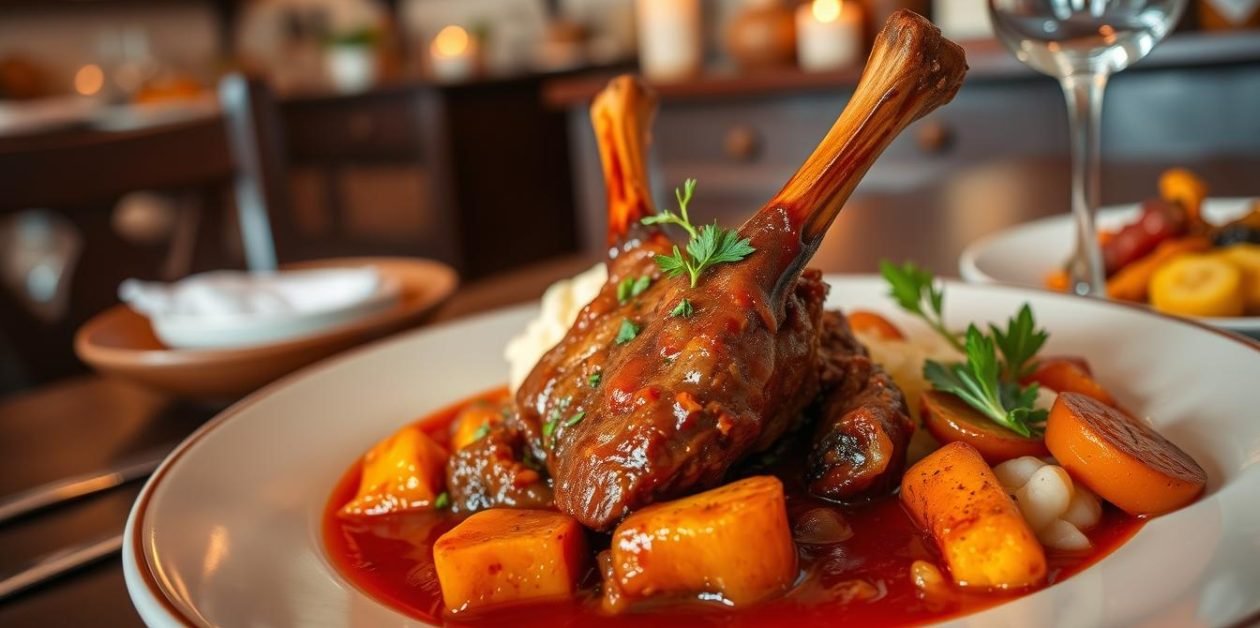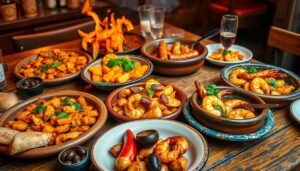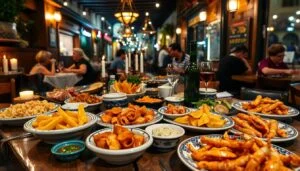Ever wondered about Spanish food treasures? Get ready for a tasty adventure. We’re exploring Rabo de Toro, a favorite dish loved by food lovers everywhere. This oxtail stew comes from Andalusia and is now loved all over Spain. It shows how Spanish food is both rich and loved by many.
Key Takeaways
- Rabo de Toro, a traditional Spanish oxtail stew, has its origins in the Andalusian region, particularly in cities like Córdoba.
- The dish has gained widespread popularity across Spain, becoming a beloved culinary staple.
- Rabo de Toro exemplifies the time-intensive preparation method of slow-braising oxtail for several hours to achieve tender, flavorful meat.
- The stew is typically prepared with a mirepoix of onions, carrots, and celery, as well as the use of Spanish Rioja red wine.
- Rabo de Toro has transcended its humble beginnings, becoming a coveted dish in high-end Spanish restaurants.
Unveiling the History of Rabo de Toro
The dish Rabo de Toro comes from Andalusia, Spain. It was made from bull tails from local fights. Now, it’s a favorite dish in Spain, loved for its rich taste.
Origins in Andalucía
Andalusia, in southern Spain, is where Rabo de Toro started. It was made from bull tails, showing the area’s love for bullfighting. This dish is a big part of Andalusia’s food culture.
Evolution into a National Treasure
Rabo de Toro has become a favorite all over Spain. It shows how Spanish cooking can turn simple meat into something special. Today, it’s famous for its tender and flavorful taste, especially in Andalusia.
| Dish | Origin | Preparation | Significance |
|---|---|---|---|
| Jamaican Oxtail Stew | Jamaica | Slow-braised oxtail in a savory sauce | Rising prices have made it more of an occasional indulgence |
| Kkori Gomtang | South Korea | Slow-simmered oxtail soup | Highlights the time-intensive nature of preparing this traditional dish |
| Coda alla Vaccinara | Italy | Slow-cooked oxtail in a tomato and vegetable sauce | Considered a “poor kitchen” dish, showcasing simplicity and use of humble ingredients |
| Rabo de Toro | Spain | Braised oxtail in a fragrant mix of tomatoes, red wine, and sherry | Traces its history back to ancient Roman times and gained popularity in the late 19th century, particularly in the Andalusian region |
Oxtail is key in these dishes. It’s bony and fatty, needing slow cooking to be tender. The price of oxtail has changed how often some dishes are made. But, these dishes are still loved, showing the creativity and love in cooking.
https://www.youtube.com/watch?v=u1LFetIYpA4
Exploring the Flavors of Rabo de Toro
The star of Rabo de Toro is the slow-braised oxtail. This Spanish stew is famous for its rich flavor and soft texture. The oxtail cooks for 2-3 hours, making it tender and creating a yummy sauce.
The oxtail is enhanced by Spanish aromatics. Onions, carrots, and celery make the base. Garlic, tomatoes, and Rioja wine add depth. Together, they create a mix of Rabo de Toro Flavors that’s loved in Spain.
| Oxtail Stew Ingredients | Slow Braising Techniques | Spanish Aromatics |
|---|---|---|
| Oxtail, olive oil, onions, carrots, celery | Simmering for 2-3 hours, using a Dutch oven | Garlic, tomatoes, red wine (Rioja) |
The secret to Rabo de Toro is the Slow Braising Techniques. Chefs cook it for hours to make the meat tender. With the right Spanish Aromatics, it’s a feast of Andalucía’s flavors.
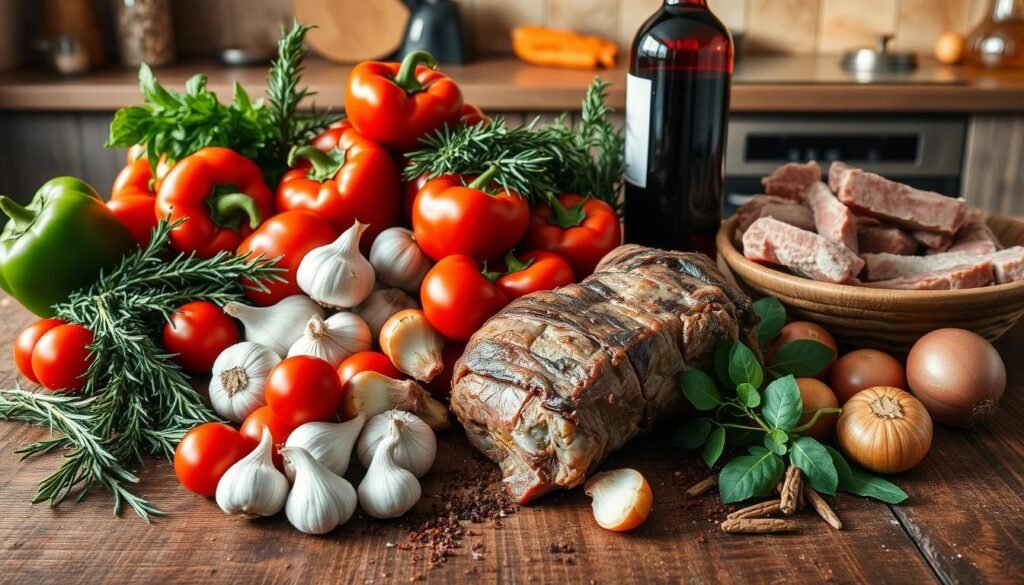
Rabo de Toro: A Culinary Canvas of Techniques
The Rabo de Toro, or Spanish oxtail stew, is loved in the Iberian Peninsula. But now, chefs are making it even better. They use Rabo de Toro Preparation to show off their Spanish Cooking Techniques.
They cook the oxtails slowly. This makes the flavors rich and the meat tender. It shows their skill in Spanish Cooking Techniques.
| Ingredient | Quantity |
|---|---|
| Oxtails | 2 lbs |
| All-purpose flour | 1/4 cup |
| Olive oil | 2 tbsp |
| Onions, diced | 2 medium |
| Carrots, diced | 3 medium |
| Garlic, minced | 4 cloves |
| Red wine | 1 cup |
| Crushed tomatoes | 1 (14oz) can |
| Beef broth | 2 cups |
| Bay leaf | 1 |
| Thyme | 2 sprigs |
| Rosemary | 2 sprigs |
This dish is both hearty and fancy. The oxtail meat is tender and full of flavor. It shows the chefs’ skill in Spanish Cooking Techniques.
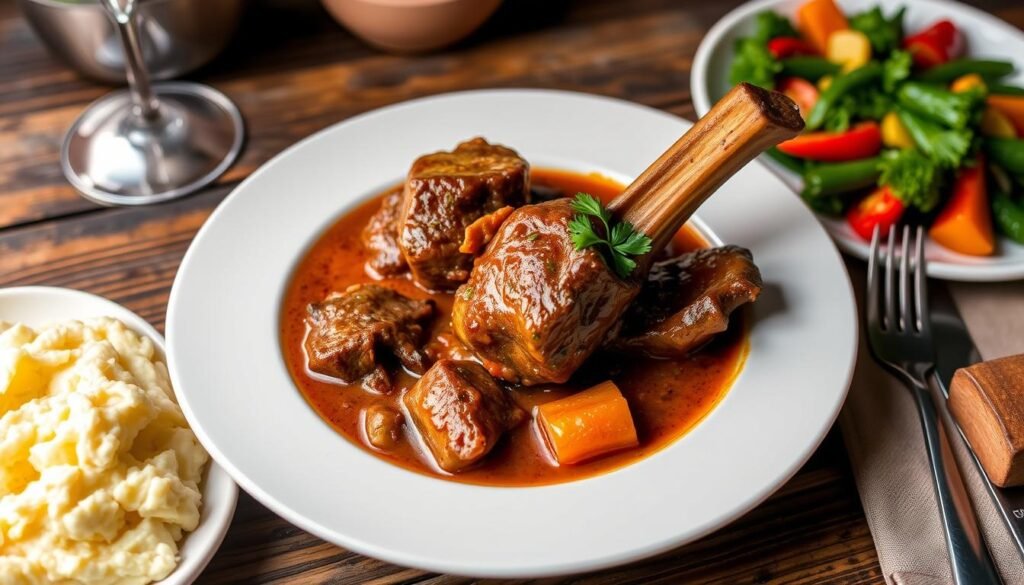
These chefs have made Rabo de Toro even more special. They mix tradition with new ideas. This makes the dish a must-try for food lovers.
Serving Rabo de Toro
Rabo de Toro is a Spanish oxtail stew loved by many. It’s a dish that deserves a special presentation. The way it’s served can make the meal even better.
Traditional Accompaniments
Potatoes or a crusty bread are common sides for Rabo de Toro. They soak up the sauce well. This lets diners enjoy every bit of the stew.
Elevating the Experience
Rabo de Toro is great for both casual and fancy meals. Some places add Spanish side dishes like greens or roasted veggies. This makes the dish look and taste even better.
The beauty of Rabo de Toro is how it brings Spanish culture to the table. It’s perfect for family dinners or special occasions. This dish truly shows off Spain’s culinary traditions.
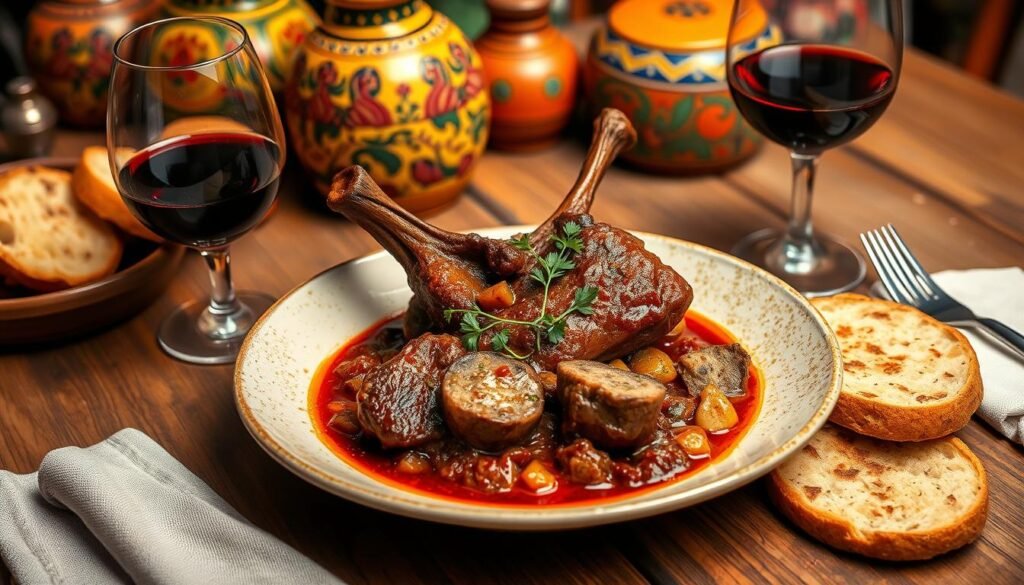
Rabo de Toro in the Modern Culinary Landscape
The evolution of Rabo de Toro shows how Spanish cuisine has grown. This traditional oxtail stew was once simple. Now, it’s found in fancy restaurants, where chefs make it special.
In Contemporary Spanish Cuisine, Rabo de Toro is a blank slate for chefs. They try new things, like slow-cooking the oxtail. This makes the dish both old and new at the same time.
More people are making Oxtail Stew Adaptations at home. This has made Rabo de Toro even more popular. It’s a dish that brings people together, blending old and new flavors.
“Rabo de Toro has become a canvas for culinary innovation, where chefs showcase their creativity while respecting the dish’s traditional roots.”
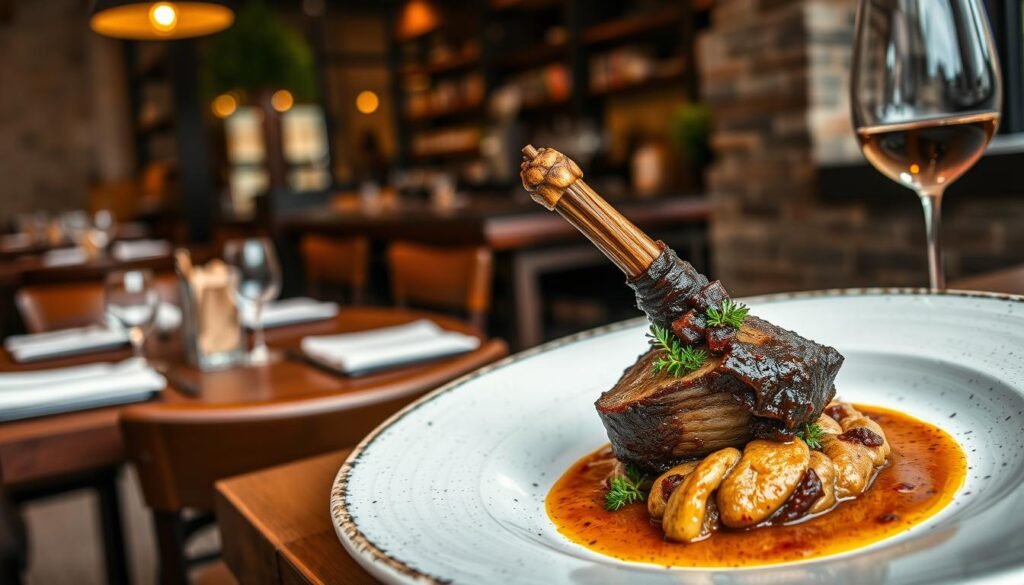
Rabo de Toro is still loved today. It’s a dish that has grown with the times. It’s enjoyed everywhere, from markets to big food events. It shows how food can bring people together.
The Comforting Appeal of Rabo de Toro
The charm of Rabo de Toro is in its deep flavors and tender meat. It’s a beloved Spanish dish. It brings warmth and hospitality to any meal.
A Dish for All Occasions
Rabo de Toro is perfect for any time. It’s great for weeknight dinners or big celebrations. This stew shows off Spanish cooking’s depth and tradition.
| Nutritional Profile of Oxtail | Benefits |
|---|---|
| 30g of protein per 100g serving | Essential for muscle repair, hormone production, and immune function |
| Higher in omega-3 fatty acids and conjugated linoleic acid (CLA) in grass-fed oxtail | Anti-inflammatory properties and linked to reduced body fat and improved immune function |
| Collagen content | Improves skin moisture, elasticity, and reduces wrinkles |
| 250-300 calories per 100g serving | Calorie-dense, requiring mindful portion control |
| Iron, zinc, selenium, and phosphorus | Supports blood cell production, immune function, antioxidant activity, and bone health |
This dish is loved in cozy settings or big feasts. It shows the rich heritage and friendly spirit of Spain.
A Taste of Authenticity: Rabo de Toro Recipe
Dive into Spain’s rich food history with this Rabo de Toro recipe. It comes from sunny Andalucía. This slow-cooked oxtail stew shows the true depth of Spanish cooking. Follow these steps to make a dish that feels like Spain.
Ingredients:
- 2 kg oxtail, cut into 2-inch pieces
- 1/4 cup all-purpose flour
- 1/4 cup olive oil
- 1 cup red wine
- 2 cups beef broth
- 1 large onion, diced
- 4 cloves garlic, minced
- 3 medium potatoes, peeled and diced
- 2 carrots, peeled and diced
- 1 celery stalk, diced
- 1 red bell pepper, diced
- 1 can (14 oz) diced tomatoes
- 2 bay leaves
- 1 tbsp fresh thyme
- 1 tbsp fresh rosemary
- 1 tsp smoked paprika
- Salt and black pepper to taste
- Chopped parsley for garnish (optional)
Instructions:
- Pat the oxtail pieces dry with paper towels and coat them evenly with the all-purpose flour.
- Heat the olive oil in a large Dutch oven or heavy-bottomed pot over medium-high heat. Sear the floured oxtail pieces in batches, turning occasionally, until they are browned on all sides, about 30 seconds per side. Transfer the seared oxtail to a plate.
- Reduce the heat to medium and add the onions, garlic, carrots, celery, and bell pepper to the pot. Cook, stirring occasionally, until the vegetables are softened, about 5 minutes.
- Pour in the red wine and use a wooden spoon to scrape up any browned bits from the bottom of the pot. Allow the wine to simmer for 2-3 minutes.
- Return the seared oxtail to the pot and add the beef broth, diced tomatoes, bay leaves, thyme, rosemary, and smoked paprika. Season with salt and black pepper to taste.
- Bring the stew to a boil, then reduce the heat to low, cover the pot, and simmer for 3-4 hours, or until the oxtail is fork-tender and the meat is falling off the bone.
- Add the diced potatoes to the pot and continue simmering for an additional 30 minutes, or until the potatoes are tender.
- Taste and adjust seasoning as needed. Serve the Rabo de Toro warm, garnished with chopped parsley if desired. Enjoy this authentic taste of Spain!
| Nutrition Facts | Per Serving |
|---|---|
| Calories | 1184.29 |
| Carbohydrates | 31.76g |
| Protein | 110.82g |
| Fat | 52.72g |
Rabo de Toro, the traditional Spanish oxtail stew, shows Spain’s culinary skill. This recipe, shared for generations, brings a delightful taste of traditional Spanish cooking to your table.
Rabo de Toro: Embodying Spanish Hospitality
Rabo de Toro is a Spanish oxtail stew that shows the warmth of Spanish food. It brings people together, whether at home or in fancy restaurants. The slow-cooked oxtail and rich sauce make it a comforting dish.
This dish is more than tasty. It’s a tradition passed down through generations. Sharing it around a table shows Spanish hospitality and the joy of food.
Travelers in Spain look for real food experiences. Rabo de Toro connects them with Spanish culture. It’s enjoyed in both home kitchens and famous restaurants, bringing people together.
“Rabo de Toro is more than just a dish – it’s a celebration of life, a symbol of the Spanish spirit that embraces the art of living and the joy of sharing good food with loved ones.”
In Madrid, Andalucía, or the Basque Country, Rabo de Toro is a key part of Spanish food. It shows the hospitality that makes Spain special.
Embracing the Flavors of Andalucía
Exploring Southern Spain takes you on a journey through Andalusian cuisine. Here, the flavors of Rabo de Toro, a traditional oxtail stew, shine. Andalusia, known for its rich culture, offers more than just this dish. It’s a place where diverse and sunny flavors blend, creating a unique culinary scene.
A Taste of Andalusian Authenticity
Andalusia is a treasure trove of food, with eight provinces each offering something special. From Almeria’s artichokes to Motril’s early potatoes, the land is full of fresh produce. The region’s dairies also make many artisanal cheeses, using milk from local goats and sheep.
Andalusia is famous for its olive oil, with top-quality oils coming from Jaen and Cordoba. Sherry, the famous Andalusian wine, adds to the region’s flavors. Its styles range from light fino to strong oloroso.
Seafood is big in Andalusian food, with red tuna, sea bream, and sole being favorites. The land also offers oxtail stew, lamb stews, and poultry dishes. These add richness and depth to the region’s food scene.
| Andalusian Culinary Highlights | Signature Dishes |
|---|---|
|
|
Exploring Andalusia’s food scene lets you see its rich culture. You’ll learn about the flavors and techniques behind its famous dishes, like Rabo de Toro. This journey through Andalusian cuisine is a chance to taste the heart of Southern Spain, where old and new meet in a unique way.
“Andalusia is a region that captivates the senses, where the flavors of the past and present converge to create a truly remarkable culinary experience.”
Conclusion
Rabo de Toro is a special Spanish oxtail stew. It shows the rich food traditions of Spain. This dish comes from Andalucía and is loved all over the country.
This stew is made with care. It has a mix of spices and takes time to cook. It’s enjoyed at home and in fancy restaurants. It shows the variety and depth of Spanish food.
Our journey with Rabo de Toro ends here. But it’s clear this stew is more than food. It’s a symbol of Spain’s warm welcome and love for good food. Rabo de Toro will keep bringing joy to many, showing Spain’s culinary spirit.

